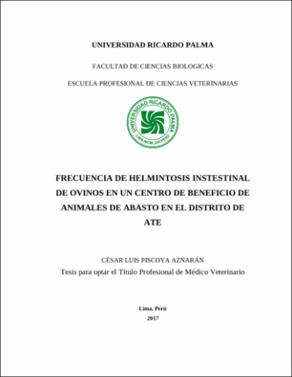Frecuencia de helmintosis instestinal de Ovinos en un Centro de beneficio de animales de abasto en el distrito de Ate
Resumen
El beneficio de ovinos en el camal de Yerbateros, se ha incrementado en los
últimos años, debido a la demanda de carne de ovino, no solo se
comercializa la carne, también utilizan la lana y las vísceras para la
producción. Este aumento en la demanda nos alerta a enfocarnos en los
parásitos en este caso intestinales que generan a la larga grandes pérdidas
económicas a los ganaderos en su producción. No tenemos estudios de
frecuencia de helmintosis intestinal realizados en el camal de Yerbateros, es
por esto que el presente estudio tuvo como objetivo obtener un precedente
sobre la frecuencia de helmintosis intestinal de ovinos en el camal de
Yerbateros. El tamaño muestral del presente estudio fue de 890 ovinos entre
hembras y machos sin restricción de edad, procedentes de distintas
provincias del Perú y/o distritos de Lima, que llegaban para ser beneficiados
al camal de Yerbateros. El muestreo se realizó entre los meses de noviembre
y diciembre del año 2016, y para su recolección y procesamiento se utilizó el
método Travassos; obteniéndose los siguientes resultados: De 890 muestras
se encontró ovinos positivos de alguna forma parasitaria 368 (41.4%);Los
parásitos encontrados fueron Moniezia sp, Nematodirus sp y Bonustomum
sp. El parásito gastrointestinal más encontrado fue la Moniezia sp (62%).
The benefit of sheep in the slaughter Yerbateros has increased in recent
years due to the demand for sheep meat, not only the meat is sold, but also
the wool and the viscera for industry. This demand increasing warns us to
focus on the intestinal parasites that generate great economic losses to
farmers . We do not have frequency studies of intestinal helminths performed
in Yerbateros slaughter , that is why the present study aimed to obtain a
precedent on the frequency of intestinal helminths of sheep in this place. The
sample size of the present study was 890 sheep between females and
unrestricted males, from different provinces of Peru and / or districts of Lima,
who came to be benefited by the slaughter of Yerbateros. Sampling was
carried out between November and December of 2016, and the Travassos
method was used for its collection and processing; We obtained 890
samples positive for parasitic 368 (41.4%); the parasites were Moniezia sp,
Nematodirus sp and Bonustomum sp. The most common gastrointestinal
parasite was Moniezia sp (62%).
Colecciones
- Medicina Veterinaria [83]


